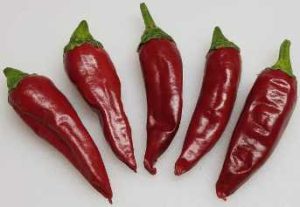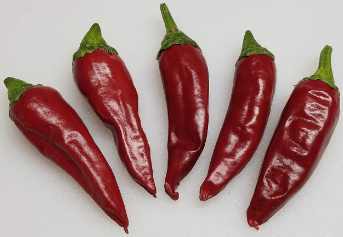Guajillo Pepper
Overview:
 Guajillo peppers are a popular ingredient in Mexican cuisine, known for their rich, smoky flavor and mild to medium heat. They’re dried poblano peppers and are often used in sauces, salsas, and marinades.
Guajillo peppers are a popular ingredient in Mexican cuisine, known for their rich, smoky flavor and mild to medium heat. They’re dried poblano peppers and are often used in sauces, salsas, and marinades.
Guajillo peppers are usually dark red or deep maroon when dried. They are relatively smooth, with a thin skin and a slightly wrinkled texture.
They have a distinct smoky, fruity taste with a hint of berry and a bit of tanginess and They are mild to medium on the Scoville scale, typically ranging from 2,500 to 5,000 Scoville Heat Units (SHU).
They’re often used to make sauces like mole or adobo, added to soups, or blended into spice mixes. To use them, they’re usually toasted lightly to enhance their flavor and then rehydrated before being blended into a paste or sauce.
Guajillo Pepper nutrition
Guajillo peppers, like other dried chili peppers, are not only flavorful but also offer some nutritional benefits. Here’s a general overview of their nutritional profile per 100 grams of dried guajillo peppers:
- Calories: Approximately 282 kcal
- Protein: About 14 grams
- Fat: Around 13 grams
- This includes a mix of saturated, monounsaturated, and polyunsaturated fats.
- Carbohydrates: Roughly 33 grams
- Dietary Fiber: About 17 grams
- Sugars: Around 8 grams
- Vitamins and Minerals:
- Vitamin C: Guajillo peppers are a good source of Vitamin C, which supports immune function and skin health.
- Vitamin A: They provide beta-carotene, which the body converts into Vitamin A for eye health.
- Vitamin E: They contain Vitamin E, an antioxidant that helps protect cells from damage.
- Iron: Guajillo peppers offer a notable amount of iron, essential for red blood cell production.
- Potassium: They are a good source of potassium, which helps maintain healthy blood pressure and muscle function.
- Calcium: They contain some calcium, which supports bone health.
- Antioxidants: Guajillo peppers are rich in antioxidants, which help combat oxidative stress and inflammation.
Guajillo chiles are generally considered to have a mild to medium level of spiciness. On the Scoville Scale, which measures the heat of peppers, guajillo chiles typically range from 2,500 to 5,000 Scoville Heat Units (SHU).
For context:
- Mild peppers, like bell peppers, have 0 SHU.
- Jalapeños have between 3,500 and 8,000 SHU.
- Habaneros are much hotter, ranging from 100,000 to 350,000 SHU.
So, guajillo chiles have a gentle heat that adds warmth and complexity without being overwhelmingly spicy. They provide a rich, deep flavor with a touch of heat, making them versatile for a variety of dishes.
Growing a guajillo pepper plant can be a rewarding endeavor if you’re interested in cultivating your own peppers. Here’s some information on how to grow and care for guajillo pepper plants:
Growing Conditions
- Climate: Guajillo peppers thrive in warm climates. They need a long growing season with temperatures consistently above 70°F (21°C). They can be grown in USDA Hardiness Zones 9-11, but in cooler regions, they can be grown in pots and brought indoors during colder months.
- Sunlight: They require full sun, ideally 6-8 hours of direct sunlight per day.
- Soil: Use well-drained soil with a pH between 6.0 and 7.0. Rich, loamy soil with plenty of organic matter is ideal.
Planting
- Starting Seeds: You can start guajillo pepper seeds indoors about 8-10 weeks before the last frost date. Sow seeds ¼ inch deep in seed-starting mix. Keep the soil moist and warm (around 75-80°F or 24-27°C) until they germinate, which usually takes 2-3 weeks.
- Transplanting: Once seedlings are strong enough and the danger of frost has passed, transplant them outdoors. Space the plants about 18-24 inches apart to give them room to grow.
Care
- Watering: Keep the soil consistently moist but not waterlogged. Peppers generally need about 1 inch of water per week, more during very hot or dry periods.
- Fertilizing: Use a balanced fertilizer or one high in potassium and phosphorus once or twice during the growing season. Avoid over-fertilizing with nitrogen, as it can lead to excessive foliage growth at the expense of fruit production.
- Pruning: Prune the plants to remove any dead or damaged leaves and to encourage a more manageable shape and better air circulation.
Harvesting
- Timing: Guajillo peppers typically take about 70-90 days from transplanting to reach maturity. The peppers turn from green to a dark red or maroon color when they are ready to harvest.
- Harvest: Cut the peppers from the plant using scissors or pruning shears. Be careful not to damage the plant while harvesting.
Post-Harvest
- Drying: Guajillo peppers are often dried to enhance their flavor. To dry them, you can hang them in a well-ventilated area or use a dehydrator. Ensure they are completely dried to prevent mold growth.
- Storage: Store dried guajillo peppers in an airtight container in a cool, dark place. They can be rehydrated for cooking or ground into powder.
What are guajillo chiles used for ?
Guajillo chiles are incredibly versatile and are used in a variety of Mexican dishes to add depth and complexity.
Some common uses for guajillo chiles:
- Mole Sauces: Guajillo chiles are a key ingredient in many mole recipes, where they contribute a rich, earthy flavor and deep color. Mole poblano, for example, often includes guajillo chiles among other ingredients.
- Salsas and Sauces: They are blended into salsas and sauces for dishes like enchiladas, tamales, and grilled meats. Their mild heat and fruity notes add a balanced spice and complexity to these condiments.
- Adobo Marinades: Guajillo chiles are frequently used in adobo marinades for meats, giving them a deep, robust flavor. This marinade is commonly used for pork, chicken, and beef.
- Stews and Soups: They are used to flavor soups and stews, such as pozole and birria. The guajillo’s subtle heat and rich taste enhance the overall flavor profile of these dishes.
- Chili Pastes: Guajillo chiles can be ground into a paste, which is then used as a base for various dishes or as a condiment.
- Seasoning Mixes: Ground guajillo chiles are often included in spice blends and rubs, providing a warm, slightly sweet flavor.
- Rice and Beans: They can be added to rice and bean dishes to impart a deeper flavor.
What is guajillo sauce made of?
Guajillo sauce is a versatile and flavorful sauce made primarily from guajillo peppers. The exact ingredients and preparation can vary depending on the recipe, but here’s a basic version to get you started:
Basic Guajillo Sauce Ingredients:
- Guajillo Peppers: The primary ingredient, which provides the sauce with its distinctive flavor. You typically need dried guajillo peppers for this sauce.
- Garlic: Adds depth and a bit of aromatic flavor. Fresh or roasted garlic can be used.
- Onion: Often used to add sweetness and complexity.
- Tomatoes: Fresh or canned tomatoes are commonly used to add richness and a bit of acidity. Some recipes might use tomato paste for a more concentrated flavor.
- Vinegar: Adds acidity to balance the sweetness and heat. White vinegar or apple cider vinegar is usually used.
- Salt: For seasoning and to enhance the other flavors in the sauce.
- Additional Spices: Depending on the recipe, you might also find cumin, oregano, black pepper, or other spices to add more depth of flavor.
- Liquid: Water or broth is used to adjust the consistency of the sauce.
Basic Preparation Method:
- Rehydrate the Peppers: Toast the dried guajillo peppers lightly in a dry skillet until fragrant, then soak them in hot water for about 20 minutes until softened.
- Blend the Ingredients: Remove the stems and seeds from the rehydrated peppers. In a blender, combine the guajillo peppers with garlic, onion, tomatoes (or tomato paste), vinegar, and salt. Blend until smooth.
- Cook the Sauce: Heat a bit of oil in a pan over medium heat. Pour the blended mixture into the pan and cook for about 10-15 minutes, stirring occasionally. Adjust the consistency with water or broth as needed and season to taste with additional salt or spices.
- Strain (Optional): For a smoother sauce, you can strain it through a fine mesh sieve to remove any remaining solids.
 Guajillo peppers are a popular ingredient in Mexican cuisine, known for their rich, smoky flavor and mild to medium heat. They’re dried poblano peppers and are often used in sauces, salsas, and marinades.
Guajillo peppers are a popular ingredient in Mexican cuisine, known for their rich, smoky flavor and mild to medium heat. They’re dried poblano peppers and are often used in sauces, salsas, and marinades. 